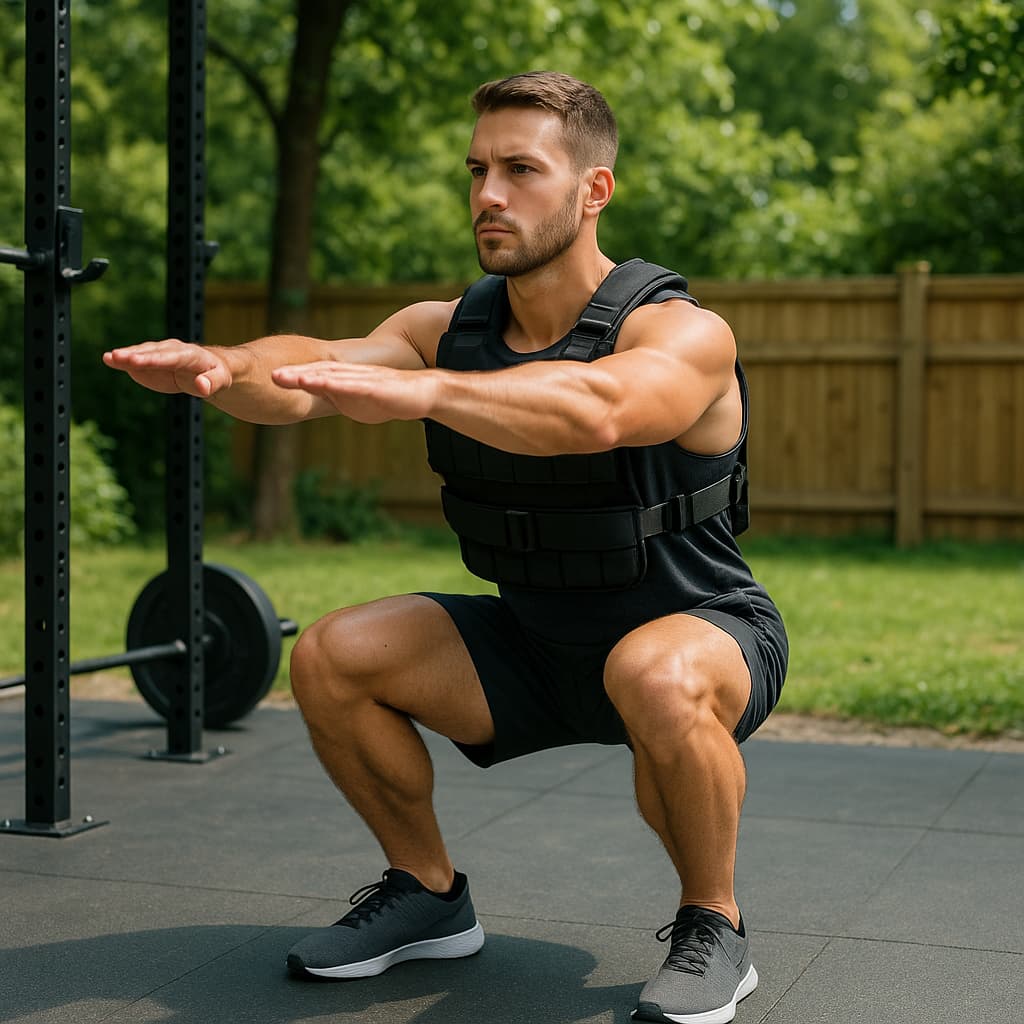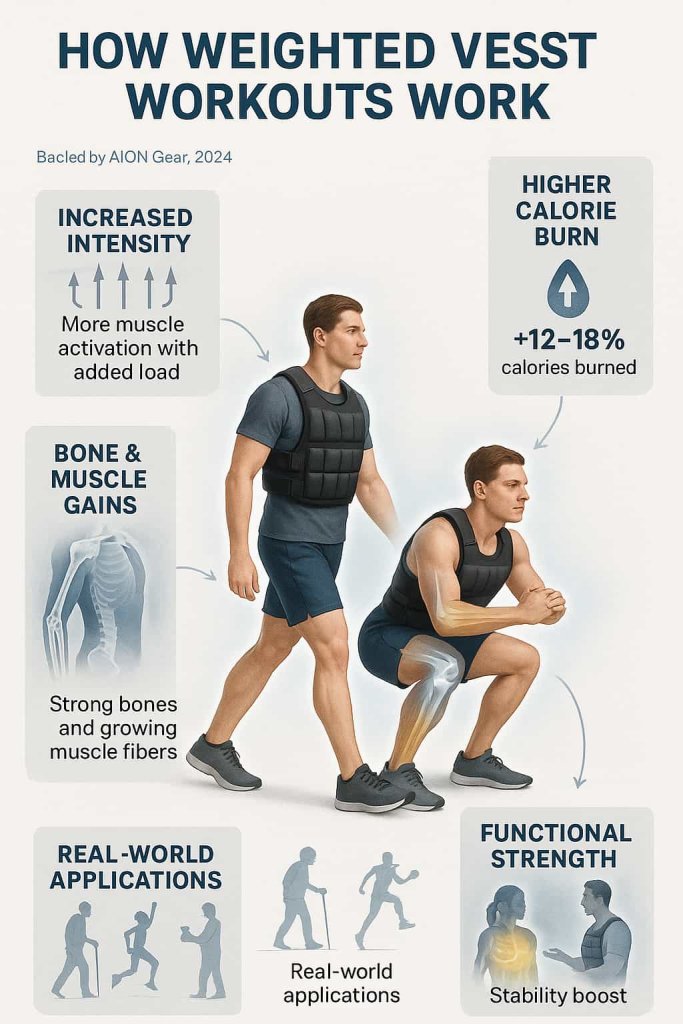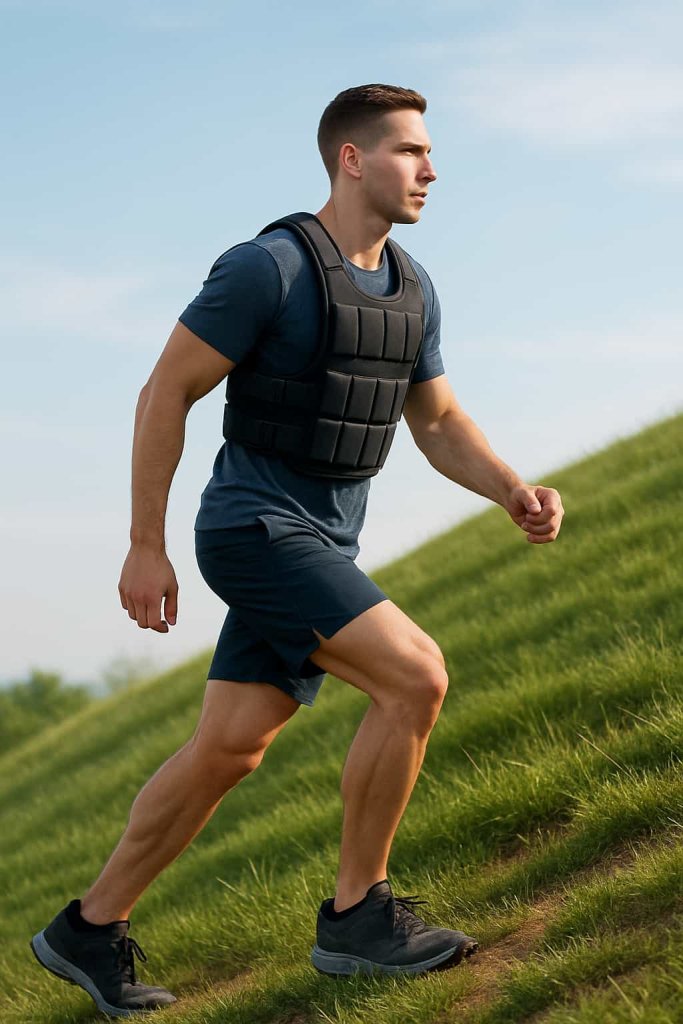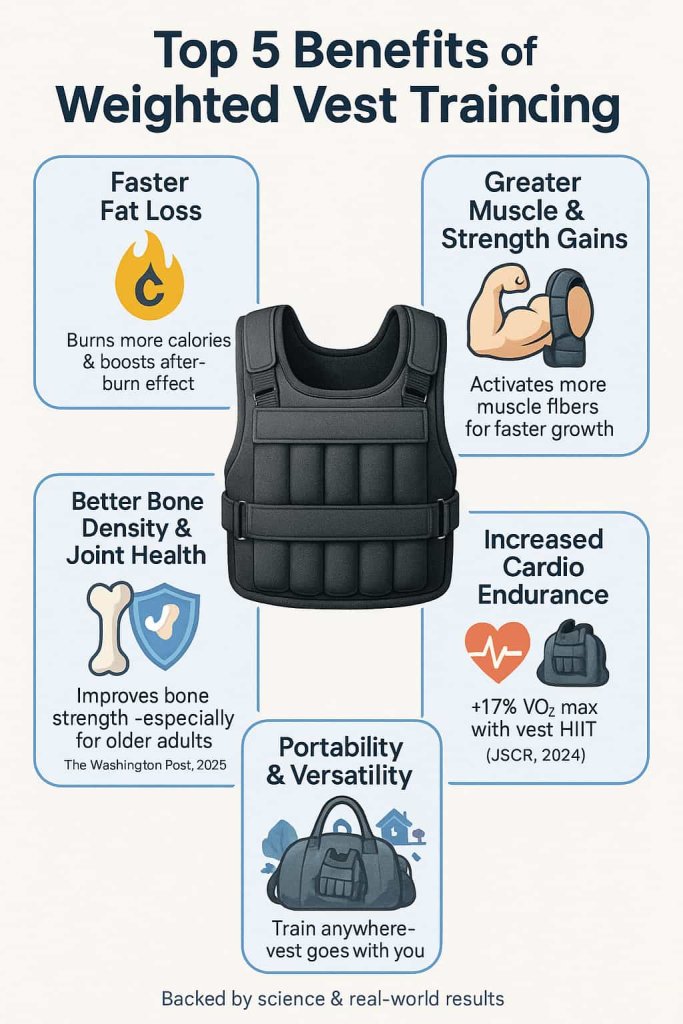Weighted vest workouts are one of the most efficient, research-supported ways to supercharge strength, muscle growth, and fat loss using minimal equipment. By simply wearing a weighted vest, you transform basic bodyweight exercises into powerful resistance moves that challenge your entire body.

Weighted vests are increasingly popular among athletes, home exercisers, and even older adults because they are affordable, portable, and highly effective. Current studies show that adding just 5–10% of your body weight in vest form can significantly boost calorie burn, muscle activation, and bone strength—all while making your favorite exercises more rewarding. ScienceAlert, 2024, Washington Post, 2025
Understanding the right way to train with a weighted vest will help you see better results, reduce your risk of injury, and keep your workouts fun and fresh. Whether your goal is building muscle, burning fat, improving athletic performance, or boosting overall health—this comprehensive guide is for you.
How Do Weighted Vest Workouts Work? (With Science)

Wearing a weighted vest means your muscles have to work harder with every rep—whether you’re walking, squatting, or sprinting. The science is clear:
- Increased Intensity: The vest adds resistance, making your muscles and heart work harder. This leads to greater improvements in strength, endurance, and calorie expenditure.
- Higher Calorie Burn: Research shows that adding a weighted vest (about 10% of your body weight) to a walk can increase calorie burn by 12–18% compared to walking without one. AION Gear, 2024
- Muscle & Bone Gains: Studies on postmenopausal women show that using a weighted vest for walking (4–8% body weight) results in greater muscle growth, fat loss, and bone strength than walking alone.
- Functional Strength: Weighted vests train your core and stabilizer muscles. Because the weight is evenly distributed, it feels more natural and less stressful on the joints compared to holding dumbbells.
Real-World Example: Personal trainers at leading gyms recommend weighted vests for clients looking to break plateaus. Many elite athletes use vests during bodyweight circuits, and even rehabilitation programs for older adults include vest-walking to improve balance, posture, and bone density (ACE Fitness).
The 15 Best Weighted Vest Workouts (For All Levels)
Weighted vests are a game-changer for functional fitness, strength, and conditioning. By adding external load to bodyweight movements, you ramp up intensity, calorie burn, and muscle activation without needing heavy equipment. This list is organized by level, so you can safely progress as you get stronger and fitter.
Beginner Weighted Vest Workouts
Start here if you’re new to vests, recovering from injury, or just want to master form with a lighter load (5–8% of your bodyweight).
1. Weighted Vest Walking
- How To: Walk briskly for 15–30 minutes outdoors or on a treadmill, focusing on upright posture, relaxed shoulders, and deep, steady breaths.
- Pro Tip: Begin with flat surfaces; progress to hills or treadmill incline as fitness improves.
- Benefits: Low-impact cardiovascular boost, gentle calorie burn, improved gait and posture.
- Mistakes to Avoid: Don’t slump forward or swing arms excessively; keep strides natural.
- Progression: Increase duration, speed, or add intervals (e.g., 1 minute fast, 1 minute easy).
2. Bodyweight Squats
- How To: Stand feet shoulder-width, brace core, push hips back and down as if sitting, keep chest tall, knees tracking over toes, then stand.
- Trainer’s Tip: Keep core engaged and heels grounded to avoid knee collapse.
- Benefits: Strengthens quads, glutes, and core—essential for everyday movement and injury prevention.
- Mistakes to Avoid: Letting knees cave in, rounding your back, or rising onto your toes.
- Progression: Slow tempo squats or add a pause at the bottom.
3. Step-Ups
- How To: Step one foot onto a sturdy bench or box, drive through heel to stand, then step down and repeat with opposite leg. Do 3 sets of 10 reps per leg.
- Practical Advice: Focus on keeping your knee aligned over your foot and your torso upright.
- Benefits: Builds unilateral (one-leg-at-a-time) leg strength, improves balance, and activates the glutes/core.
- Mistakes to Avoid: Using too high a box (knee above hip), letting knee cave inward, or pushing off with the trailing foot.
- Progression: Increase box height or add a knee drive at the top.
4. Push-Ups
- How To: Hands shoulder-width, lower chest to floor, elbows at 45°, press up. Do 3 sets of 8–12 reps.
- Real-World Use: Perfect for adding resistance if standard push-ups feel too easy—great for building upper-body and core strength.
- Benefits: Targets chest, triceps, shoulders, and core; weighted version boosts muscle growth and endurance.
- Mistakes to Avoid: Letting hips sag or flaring elbows too wide.
- Progression: Elevate feet or try decline push-ups.
5. Standing Calf Raises
- How To: Stand on a step or flat ground, rise onto balls of feet, pause, lower heels below step level. 3 sets of 15–20 reps.
- Quick Tip: Use a sturdy step for greater range and calf activation.
- Benefits: Strengthens calves, ankle stability, and balance—great for runners and active people.
- Mistakes to Avoid: Bouncing reps or locking knees.
- Progression: Try single-leg calf raises.
Intermediate Weighted Vest Workouts
For those with a few weeks’ vest experience (7–10% of your bodyweight).
6. Walking Lunges
- How To: Step forward, lower back knee gently to floor, keep chest up, push off front foot. Alternate legs for 3 sets of 10 reps each.
- Expert Insight: Hits quads, glutes, hamstrings, and challenges balance and hip stability.
- Benefits: Increases lower-body muscle and functional strength, essential for sports and real life.
- Mistakes to Avoid: Letting knees track inward or stepping too narrow.
- Progression: Hold dumbbells for more load.
7. Incline or Hill Walks

- How To: Set treadmill at 5–10% incline or walk uphill outside for 20–30 minutes.
- Research-Backed: Walking uphill increases muscle activation in glutes, hamstrings, calves, and torches more calories (Harvard Health, 2024).
- Benefits: Builds lower-body endurance, cardiovascular fitness, and burns more fat than flat walking.
- Mistakes to Avoid: Holding treadmill rails or overstriding.
- Progression: Add speed intervals or increase incline over time.
8. Plank Holds
- How To: Forearms on floor, elbows under shoulders, body in straight line, hold for 30–60 seconds (2–3 sets).
- Trainer Tip: Squeeze glutes and brace abs to prevent sagging.
- Benefits: Strengthens entire core (abs, obliques, back), improves stability and posture.
- Mistakes to Avoid: Letting hips drop or shoulders shrug up.
- Progression: Try side planks or extended planks.
9. Bench Dips
- How To: Hands on bench behind you, legs straight or bent, lower body by bending elbows, press back up. 3 sets of 10–12 reps.
- Modification: Bend knees for beginners or elevate feet for more challenge.
- Benefits: Builds triceps, chest, and shoulders.
- Mistakes to Avoid: Dropping hips too low, flaring elbows wide.
- Progression: Add a second bench for feet or slow down the tempo.
10. High Knees or Marching in Place
- How To: Jog or march in place, lifting knees as high as possible for 30–60 seconds, repeat 4–6 rounds.
- Cardio Boost: Adds intensity and improves conditioning for HIIT circuits.
- Benefits: Increases heart rate, improves hip flexor and core strength.
- Mistakes to Avoid: Leaning back or landing heavily.
- Progression: Add speed or try skipping rope with the vest.
Advanced Weighted Vest Workouts
For experienced athletes. Use 10–12% of bodyweight max; prioritize perfect form over weight.
11. Jump Squats
- How To: Perform a deep squat, then explode up into a jump, land softly, and immediately squat again. 3 sets of 8–10 reps.
- Trainer Tip: Focus on soft landings to absorb force through hips and knees.
- Benefits: Boosts explosive power, athleticism, and calorie burn.
- Mistakes to Avoid: Hard landings or knees caving in.
- Progression: Try single-leg hops or broad jumps.
12. Burpees
- How To: Squat, hands down, jump to plank, do push-up, jump feet forward, leap up. 3 sets of 10 reps.
- HIIT Favorite: One of the best full-body, fat-torching moves—combining cardio and strength.
- Benefits: Works nearly every muscle group, excellent for conditioning and rapid fat loss.
- Mistakes to Avoid: Skipping the push-up or landing hard.
- Progression: Add a pull-up at the top for “ultimate burpee.”
13. Pull-Ups
- How To: Hang from bar, palms facing away, pull up until chin clears bar, lower with control. 3 sets of 5–8 reps.
- Science Note: EMG studies show weighted pull-ups activate lats, biceps, and core more than bodyweight alone (NSCA, 2023).
- Benefits: Unmatched for upper-back, arm, and grip strength.
- Mistakes to Avoid: Kipping (unless intended), incomplete reps, or craning neck.
- Progression: Add pause at top or try neutral grip.
14. Bulgarian Split Squats
- How To: Stand a few feet in front of bench, place back foot on bench, lower front thigh parallel to ground, stand back up. 3 sets of 8 reps per side.
- Great For: Improving single-leg strength, balance, and glute growth.
- Benefits: Targets glutes, quads, stabilizers; corrects imbalances and boosts athletic performance.
- Mistakes to Avoid: Letting front knee track past toes, leaning forward.
- Progression: Hold dumbbells or add a hop at the top.
15. Mountain Climbers
- How To: Start in plank, drive knees to chest, alternating quickly. Do 30 seconds on, 30 seconds off, for 5 rounds.
- Bonus: Core and cardio powerhouse—builds endurance and coordination.
- Benefits: Torches calories, strengthens abs, hip flexors, shoulders.
- Mistakes to Avoid: Letting hips rise, moving too slowly.
- Progression: Try cross-body or “spider” mountain climbers.
How to Use These Weighted Vest Workouts
- Choose 2–4 moves per session, mixing upper, lower, and core for a full-body routine.
- For fat loss: Combine several into a circuit with minimal rest between moves.
- For strength: Focus on slower reps, longer rests, and good form.
- For athleticism: Prioritize explosive exercises (jump squats, burpees) and single-leg moves.
How to Use a Weighted Vest Safely (With Trainer Advice)
- Start Light: Experts recommend beginning with 5–8% of your bodyweight; for most adults, that’s 5–8 kg (11–18 lbs).
- Prioritize Good Form: The #1 injury risk is poor movement mechanics. Never let the vest pull your shoulders forward or arch your back.
- Increase Slowly: Add weight or time only after 2–4 weeks of consistent training.
- Mix Training Types: Alternate between resistance, cardio, and HIIT workouts for best results.
- Rest & Recover: Take at least 1–2 days off from weighted vest training per week.
- Fit Matters: Make sure the vest sits close to your torso and the weight is evenly distributed.
For detailed guidance, check out the ACE Fitness FAQ on Weighted Vests.
Real-World Examples: Who Uses Weighted Vests?
- Athletes: Football players, runners, and martial artists add vests to build strength and explosiveness.
- Fitness Classes: Group bootcamps use vests for circuits, intervals, and team challenges.
- Home Gym Enthusiasts: People training in small spaces or without heavy equipment use vests for squats, push-ups, and HIIT.
- Active Older Adults: Vests are popular for walking or step-ups to protect bone health and prevent falls.
- Rehabilitation Programs: Physical therapists use weighted vests to help clients regain stability and strength after injury.
Benefits of Weighted Vest Training
1. Faster Fat Loss
Adding weight increases your body’s energy demands, burning more calories during every session. High-intensity moves like sprints, hill walks, and burpees with a vest ramp up fat loss even after your workout ends (the “afterburn” effect).

2. Greater Muscle and Strength Gains
Muscles adapt to increased load. Weighted vests force your body to work harder on push-ups, squats, lunges, and even pull-ups—stimulating more muscle fibers for strength and growth.
3. Better Bone Density & Joint Health
Wearing a vest during weight-bearing activities (walking, lunges, step-ups) helps improve bone mineral density, especially for older adults or women at risk for osteoporosis (Washington Post, 2025).
4. Increased Cardio Endurance
Vest workouts raise your heart rate. A 2024 report in The Journal of Strength and Conditioning Research found that HIIT with a weighted vest led to a 17% improvement in VO2 max versus bodyweight HIIT alone.
5. Portability & Versatility
A vest is lightweight, easy to travel with, and can turn any environment—home, park, gym—into a full-body workout space.
Frequently Asked Questions (FAQ)
Q: Can I wear a weighted vest every day?
A: You can use a vest for walking daily, but higher-intensity workouts (HIIT, plyometrics, heavy resistance) should be limited to 2–4 times per week to avoid overuse injuries.
Q: How heavy should my vest be?
A: Most adults do best with 5–10% of their bodyweight. Only go heavier with experience and perfect form.
Q: Are weighted vests safe for seniors?
A: Yes, with medical clearance and a light load. Research supports improved bone and muscle health in seniors who use vests for walking or light training.
Q: Can I use a weighted vest for running?
A: Running with a vest is advanced. Start with walks, then progress. Never run with more than 10% bodyweight to protect your joints.
Q: What’s the best brand or type?
A: Choose an adjustable, snug-fitting vest. Brands like Hyperwear, Mir, and Rogue are popular in the US. Always check product reviews and sizing.
Pro Tips for Success
- Warm Up Thoroughly: Always do dynamic stretching and light movement before vest workouts.
- Monitor Your Posture: Stand tall, keep shoulders back, and core engaged at all times.
- Stay Hydrated: Extra weight = extra sweat! Drink water before, during, and after.
- Track Your Progress: Use a fitness app or journal to note workouts, reps, and how you feel.
- Switch Up Your Routine: Rotate between different vest workouts to avoid plateaus and overuse injuries.
Conclusion
Weighted vest workouts are an affordable, flexible, and research-backed way to build muscle, strength, and lose fat—no fancy gym required.
Start light, focus on perfect form, and challenge yourself with these 15 proven moves. With consistency and smart progression, you’ll see stronger muscles, a leaner body, and better overall health.
Authoritative External References Used
- ScienceAlert – Weighted Vests and Fitness
- Washington Post – Bone Strength and Weighted Vests (2025)
- AION Gear – Weighted Vest Science
- ACE Fitness – Official Resource
- National Strength and Conditioning Association (NSCA) – Weighted Vest Training Guide (2023)
- Harvard Health – Walking for Health: The Ultimate Exercise (2024)
- ACE Fitness – The Benefits of Bodyweight Training (2024)
